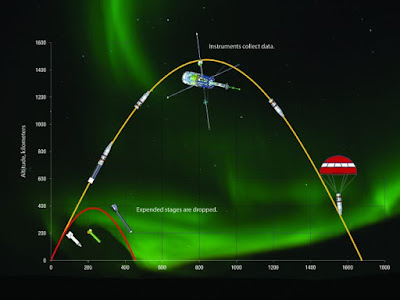NASA rockets to create glowing white artificial clouds next week
latestnews1947: A NASA rocket mission to study disturbances in the upper atmosphere that interfere with communication and technology systems will form night-time white artificial clouds during two flights between August 29 and September 9.
The artificial clouds will be visible for residents of the Republic of the Marshall Islands, NASA said.
The Waves and Instabilities from a Neutral Dynamo, or WINDY, mission will study a phenomenon that occurs in the ionosphere - a layer of charged particles in the upper atmosphere.
Known as equatorial spread F, or ESF, these disturbances occur after sunset at latitudes near the equator in part of the ionosphere known as the F region.
The disturbances interfere with radio communication, navigation and imaging systems and pose a hazard to technology and society that depends on it.
The WINDY mission consists of two NASA suborbital sounding rockets that will be launched from Roi-Namur island in the north part of the Kwajalein Atoll in the Marshall Islands.
The Kwajalein Atoll in the Marshall Islands is near the magnetic equator, where post-sunset ionosphere storms are more intense, making the site an ideal location for these studies.
One rocket will carry a substance called tri-methyl aluminum, or TMA. This substance will form the white artificial clouds that glow in the night sky, the US space agency said.
Scientists on the ground will photograph the movement of these clouds to measure the winds and energetic particles that are in motion in the upper atmosphere.
The clouds are expected to be visible for about 30 minutes.
The second rocket, a two-stage 36-foot long Terrier-Malemute, will be launched five minutes after the first rocket. The second rocket carries instruments to measure ionosphere densities and electric and magnetic fields present in these storms.
The ionosphere is defined as the layer of Earth's atmosphere that is ionized by solar and cosmic radiation.
The artificial clouds will be visible for residents of the Republic of the Marshall Islands, NASA said.
The Waves and Instabilities from a Neutral Dynamo, or WINDY, mission will study a phenomenon that occurs in the ionosphere - a layer of charged particles in the upper atmosphere.
Known as equatorial spread F, or ESF, these disturbances occur after sunset at latitudes near the equator in part of the ionosphere known as the F region.
The disturbances interfere with radio communication, navigation and imaging systems and pose a hazard to technology and society that depends on it.
The WINDY mission consists of two NASA suborbital sounding rockets that will be launched from Roi-Namur island in the north part of the Kwajalein Atoll in the Marshall Islands.
The Kwajalein Atoll in the Marshall Islands is near the magnetic equator, where post-sunset ionosphere storms are more intense, making the site an ideal location for these studies.
One rocket will carry a substance called tri-methyl aluminum, or TMA. This substance will form the white artificial clouds that glow in the night sky, the US space agency said.
Scientists on the ground will photograph the movement of these clouds to measure the winds and energetic particles that are in motion in the upper atmosphere.
The clouds are expected to be visible for about 30 minutes.
The second rocket, a two-stage 36-foot long Terrier-Malemute, will be launched five minutes after the first rocket. The second rocket carries instruments to measure ionosphere densities and electric and magnetic fields present in these storms.
The ionosphere is defined as the layer of Earth's atmosphere that is ionized by solar and cosmic radiation.




Comments
Post a Comment